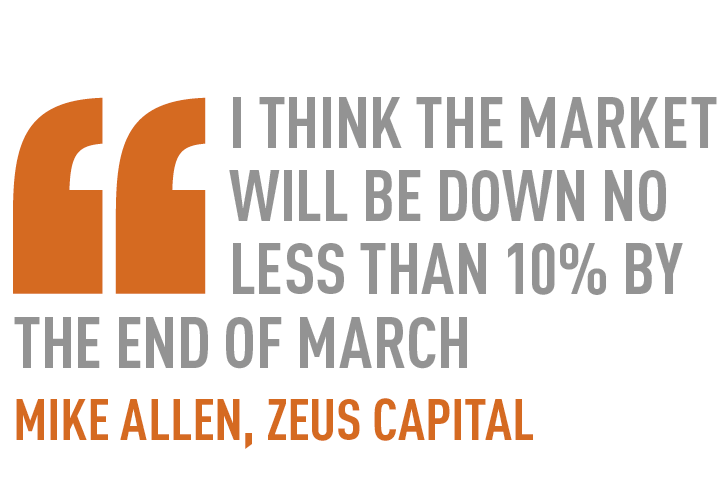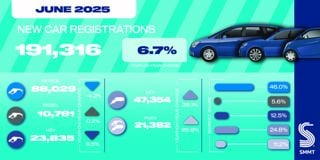Plummeting demand for diesel cars in the final quarter of last year has been partially blamed for the Society of Manufacturers and Traders (SMMT) underestimating the size of the full-year decline in new car registrations by 21.7% just two months earlier.
The society’s forecast, issued in November, predicted a fall of 4.7% in new car registrations for 2017, compared with the previous 12 months. The SMMT’s prediction in July 2017 was that full-year volumes would be down by just 3.7% (at 2.594 million). However, the full-year market actually fell by 5.7%, a disparity of almost 27,000 vehicles.
Most of that fall came in diesel – volumes fell by 30.6% in November and 31.1% in December year-on-year to leave the fuel type’s registrations down 17.1% for the whole of 2017. An SMMT spokeswoman told AM that consumers had chosen to “sit tight” rather than opt to buy a new petrol or AFV.
The result was a market down 11.2% and 14.4% during the last two months of the year.
National Franchised Dealers Association (NFDA) director Sue Robinson cited SMMT predictions from January 2017 – a full-year fall of 5% – when she claimed that 2017’s registrations were “in line with the forecasts”.
“The UK new car market closed 2017 in line with the forecasts at the start of the year, which predicted a decline in registrations following 2016’s record performance,” she said.
Peter Smyth, director at Swansway Garages, suggested that the SMMT forecasts continued to reflect the “unrealistic” volume targets of manufacturers.
“The forecast will be right according to what the manufacturers tell the SMMT, but that doesn’t mean they are right for the market,” he said.
“Add up all manufacturer projections for a given year and they’ll probably amount to four million vehicles.
“Manufacturers’ forced targets and market demand continue to be like chalk and cheese. I’d suggest the new car market is probably closer to 2.1m than 2.5m.”
In an NFDA statement that predicted a further “moderate” decline in registrations during 2018, Robinson cited the volatility of the market in 2017 as the cause of the fall in volumes.
Commenting on the SMMT forecasts, she told AM: “Forecasts by nature tend to give only broad indicators of what to expect. Dealers and those who need to use forecasts should look at different sources, since relying purely on one source could lead to inaccuracies in planning.
“We would suggest that dealers speak to the NFDA, their own manufacturers, financial analysts and banks, and monitor their own business performance in order to get as accurate as possible figures.”
How dealers can plan for a volatile 2018
Smyth told AM that strategic planning and budgetary considerations at Swansway begin around August for the following year and depend as much on knowledge of previous years’ performance as predictions about the future.
He conceded that cost-cutting and operating efficiencies would be at the forefront of the group’s planning for this year, in a period unlikely to reflect what has come before.
Super Group, which added to its existing Allen Ford network with the acquisition of Essex Auto Group in March and Slough Motor Group in July, said it does take heed of what the SMMT projects for the market, along with various internal and external sources of information, including industry data from Bloomberg and the AM100’s PLCs.
Colin Brown, the South African dealer group’s chief financial officer, said the group had seen “no unexpected changes in our volume targets in Q4”.
Mike Allen, market analyst at Zeus Capital, keeps constant tabs on the automotive sector’s PLCs in order to inform investor decisions.
Allen told AM that his predictions for overall market volumes in 2018 would be “more conservative” than those of the SMMT, which currently predict cars registrations of 2.426 million, down 5.4% on the 2017 forecast level but just 3.1% down on the 2.54 million registrations actually achieved in 2017.
He said: “I think we’re in for a very difficult first quarter and, in light of the strong start to 2017, the market will be down no less than 10% by the end of March.”
However, as car retailers move into 2018 and ongoing anti-diesel sentiment and faltering consumer confidence continue to dent sales volumes, the SMMT’s difficulties with data highlight the challenges of accurately charting a course through a year to ensure a business emerges in good shape.
If the body representing manufacturers operating in the UK cannot accurately assess where the market may be in two months’ time – having compiled a forecast with the input of those very manufacturers – how can retailers accurately budget for the year and weigh up investments?
Michael Bills, managing director of restructuring advisory at financial consultants Duff & Phelps, said “accurate forecasting and planning ahead” would be essential for retailers attempting to manage a tricky economic period, adding that: “Manufacturers will not want to see long-standing dealerships suffering and possibly even disappearing as a result of an economic slowdown.”
Did it fall, or was it pushed?
Mike Jones, the chairman of ASE, agreed with Smyth that retailers’ business plans are determined more by their manufacturer partners’ volume targets than predictions published by the SMMT.
“From a fundamental point of view, retailers will pay some regard to the SMMT stats, but they are much more concerned about their
franchise targets. The extent to which the manufacturer targets roll into the SMMT forecasts is a different issue. If you had a crystal ball that could see all the growth aspirations of all the brands, it would be way above the real market.
“We know for a fact that many of the manufacturers did tone down their targets towards the end of the year and gave their retailers targets that they could realistically aim for, but those retailers will not have achieved full-target earnings all the same.”
Jones added: “With all the changes in tack we are seeing, the market as a whole is very hard to predict and that does pose a challenge for retailers.
“Take Vauxhall, for example. Suddenly there are huge changes in their numbers and that has a knock-on effect on Ford, which no longer has to push as hard to maintain that number one position.”
Jones said manufacturers would be able to forecast their retailers’ target and bonus schemes in a fairly predictable manner, despite the market forces at play, which include fluctuations in the value of sterling for importing brands.
He said: “We have to bear in mind the fact that, as an industry, we have always registered as many cars as the manufacturers have wanted us to register. That allows the manufacturers to develop quite robust plans.”
James Dower, senior editor of Black Book at Cap HPI, agreed: “The number of vehicle registrations is not necessarily a true reflection of new car demand and is often more of a measure of the potential profitability of the UK market when compared with other areas of Europe.
“The deterioration in the exchange rate against the euro was a significant factor in the declining registration activity as comparative profitability was less than in 2016.
“As the year progressed, we saw a greater proportion of manufacturers apply less pressure on dealer targets which, in turn, led to fewer pre-registrations taking place.”
Robert Tallentire, a director at Duff & Phelps, suggested that manufacturers’ registration predictions were probably up to 40% above the true market.
Tallentire said it was “unlikely that most dealers are even using the SMMT’s predictions to forecast their investment decisions as they remain largely dependent on manufacturers’ predictions and forecasts”.
However, he said smaller retailers may not have access to the same forecasting resources as larger retail groups, leaving them more at risk from to market changes.
“It is important to recognise that it is the smaller, independent dealers who are likely to be most vulnerable to volatility in the market,” he said.
“As smaller dealers tend to have just two or three brands in their franchise, they are naturally more susceptible to fluctuations in the market and must think more strategically about how they invest capital.”
How good are the car market's predictions?
The market stability of the past seven years could be coming to an abrupt end if analysis of new car registration forecasts over the past decade is to be taken as an accurate indicator.
The last time that the SMMT’s quarterly forecasts under-estimated a fall in annual registrations was 2008. It was a miss the society was sure not to repeat, with plunging predictions the following year, and one which it has shied away from in the growth years since.
Looking at the average of the SMMT’s highest and lowest predictions for every year since 2007 shows that the actual full-year registrations are always within about a fifth of a percentage point – its quarterly survey of its members is generally accurate.
However, the tight correlation between forecasts and actual registrations is clearly most evident during periods where the market is in growth, with consumer and retailers better placed to absorb the influx of vehicles into the market through sales and tactical pre- registrations.
With consumer confidence and manufacturers’ imports hit by uncertainty surrounding Brexit, the weakening of sterling, rising inflation and interest rate rises, 2017 may have marked the start of a new period of consumer uncertainty and, with that, market unpredictability.
Whether the SMMT dramatically re-evaluates its forecasts for the year ahead or not, the automotive sector has to hope that the last quarter’s disparity between its forecast and the year’s eventual outcome is not followed by a dramatic downward trend similar to that in the last recession.
Full-year new car registrations versus highest and lowest forecasts (source: SMMT)
The market stability of the past seven years could be coming to an abrupt end if analysis of new car registration forecasts over the past decade is to be taken as an accurate indicator.
The last time that the SMMT’s quarterly forecasts under-estimated a fall in annual registrations was 2008. It was a miss the society was sure not to repeat, with plunging predictions the following year, and one which it has shied away from in the growth years since.
Looking at the average of the SMMT’s highest and lowest predictions for every year since 2007 shows that the actual full-year registrations are always within about a fifth of a percentage point – its quarterly survey of its members is generally accurate.
However, the tight correlation between forecasts and actual registrations is clearly most evident during periods where the market is in growth, with consumer and retailers better placed to absorb the influx of vehicles into the market through sales and tactical pre- registrations.
With consumer confidence and manufacturers’ imports hit by uncertainty surrounding Brexit, the weakening of sterling, rising inflation and interest rate rises, 2017 may have marked the start of a new period of consumer uncertainty and, with that, market unpredictability.
Whether the SMMT dramatically re-evaluates its forecasts for the year ahead or not, the automotive sector has to hope that the last quarter’s disparity between its forecast and the year’s eventual outcome is not followed by a dramatic downward trend similar to that in the last recession.



















Login to comment
Comments
No comments have been made yet.